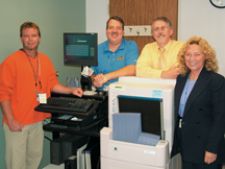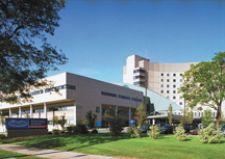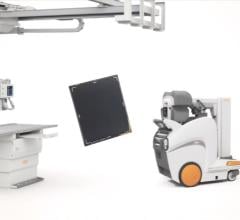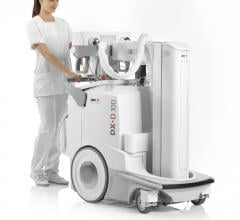
Today there is no question that a digital infrastructure – modalities and information systems – increase departmental efficiency and productivity, while at the same time enhances patient care. Digital radiography – whether it is the phosphor-based computed radiography (CR) or flat panel detector-based direct radiography – are at the cornerstone of this evaluation. Benefits of phosphor-based digital radiography systems, or CR, include the ability to retrofit an existing room, providing a lower cost entry point and the flexibility and capability to perform numerous exams that flat-panel detector-based technologies are not able to support due to patient positioning. The availability of an upright, cassetteless CR system makes it possible to provide a high throughput, total clinical and enterprise-wide solution when combined with the popular cassette-based CR systems. And this is what Henry Ford Wyandotte hospital discovered.
In 2004, Dorothy Barr, director, Medical Imaging, began the journey to a digital environment. “Our goal was to improve patient care by providing an efficient system for capturing, storing, retrieving and displaying images,” quoted Barr. For Barr, providing physicians with immediate access to an image would further ensure timely treatment for all patient populations.
While the installation of PACS was a natural conclusion, Barr knew that her department must also invest in digital modalities to not only fulfill the goal of enhancing patient care, but also to realize the economic benefits of an electronic infrastructure. X-ray was one of the first modalities Barr investigated.
“We conducted due diligence and evaluated all available digital radiography technologies, including computed radiography and flat-panel radiography,” Barr explained. While these technologies had distinct advantages and disadvantages, she was concerned about the higher capital cost of flat-panel-based direct radiography systems. “There are fewer steps involved with DR; however, it would also require the replacement of all X-ray rooms. CR is a more cost-effective alternative, as it can be implemented with existing radiographic systems, while delivering great image quality,” Barr said.
Selecting and Installing the CR Solution
Barr created a selection team consisting of radiologists, managers, lead technologists, imaging informatics specialists and staff technologists. After much consideration, the team selected Konica Minolta as its preferred vendor. “Konica Minolta was the overwhelming choice based on performance, ease of use, image quality, footprint, service and affordability,” Barr said. “In particular, the Xpress CR was rated by the team and was superior in all categories. Plus, with Konica Minolta, we could customize the configuration to meet all of our clinical requirements.”
In addition to the Xpress CR, the team also selected the REGIUS Model 350 System, an upright digital radiography system from Konica Minolta. With a phosphor-based detector, the REGIUS 350 can support a variety of clinical applications fast, as the scanning mechanism is built into the system, eliminating the need to separately process the plate.
Preparing the department for the conversion to digital was not a simple task. “We decided the best approach was to implement the new technology in several phases,” Barr explained. The first step included a Konica Minolta applications specialist who conducted training.
Phase I then centered on the emergency department. With over 35,000 radiographic procedures performed in two radiographic rooms, immediate access to images was crucial. Improving turnaround time for X-rays in the ED was the facility’s first priority. To accomplish this task, two Xpress CR systems were placed in the ED’s general radiographic rooms. “We believed that having a system in each room would improve productivity and provide redundancy,” Barr added. A REGIUS 350, which does not require cassettes, was also installed to increase throughput for chest and upright exams.
“We were anticipating some problems might occur on the ‘go-live’ date,” Jodie Dennison, lead technologist, said, “but it couldn’t have been a smoother transition.”
During the next year, Phase II and Phase III were rolled out. This included installation of an Xpress CR in the ICU and CCU, which allowed processing of portable images directly on each nursing unit. Another five Xpress CR systems were installed in the main radiology and surgery departments.
Exceeding Expectations
Although the primary impetus for converting to a digital environment was to enhance patient care by providing near-immediate access to images, Henry Ford Wyandotte has experienced numerous other benefits.
Since the installation of CR, Steve Nosakowski, radiology manager, noted a significant increase in department productivity. “The median length of time for a chest examination is now eight minutes, compared to 18 minutes for conventional radiography,” said Nosakowski. Also, portable images are reviewed by the physician on the nursing unit within seconds, compared to the historical 30-45 minutes with film-screen systems.
“Image quality is rated superior to conventional radiography by both radiologists and referring physicians,” Barr added. Better images can lead to quicker, more accurate diagnoses as well.
For imaging informatics specialists Nelson Perugi and Mike Whorley, the excellent performance and minimal system downtime of Konica Minolta’s CR solutions reinforce the extensive system evaluation at Henry Ford Wyandotte. Ease of use is underscored by the fact that technologists can troubleshoot and correct many minor situations without a service call.
“Overall, there is a very high level of satisfaction with our new CR technology,” Perugi said.
Added Whorley, “Physicians love the speed with which they can access images.”
Embarking on a digital environment can be a successful initiative with due diligence and extensive system evaluation, as evidenced by the experience at Henry Ford Wyandotte Hospital.



 December 03, 2020
December 03, 2020 









